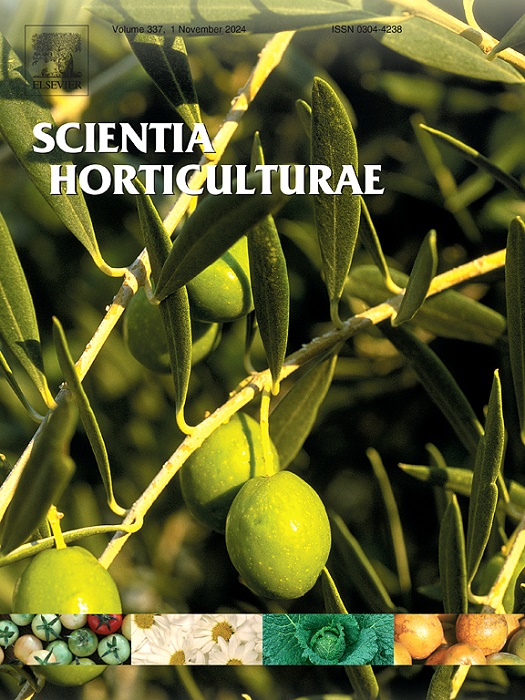利用GWAS分析桑树种质资源的表型多样性和遗传结构:关键候选基因及其分子育种潜力
IF 3.9
2区 农林科学
Q1 HORTICULTURE
引用次数: 0
摘要
桑树(Morus spp.)是一种具有重要经济价值的树种,在养蚕、传统医药和生态恢复等方面具有重要价值。桑树种质在枝、叶、芽等性状上表现出丰富的表型多样性。在本研究中,我们分析了179份桑树材料的16个表型性状,包括栽培和野生资源。简化基因组测序评估遗传结构并进行全基因组关联分析(GWAS)。结果表明,枝条颜色的多样性指数较高(H = 1.69),叶重的变异系数较高(35.39%)。216份材料的群体遗传结构分析将其划分为两大类群:以“和野白”(2n=28)为代表的栽培桑(G2)和以M. notabilis (2n=14)为代表的野生桑(G1)。GWAS利用32120个有效标记鉴定出52个显著标记-性状关联(mta),其中位点pos18665657 (Chr8)和pos7501771 (Chr10)分别与叶面积和叶重密切相关。选择性扫描分析进一步发现了102个潜在的野生桑与栽培桑差异的候选基因。此外,与叶面积相关的20个候选基因和与节间长度相关的10个候选基因被优先排序。这些发现增强了我们对桑树进化的理解,并为分子育种计划提供了有价值的见解。本文章由计算机程序翻译,如有差异,请以英文原文为准。
Unraveling phenotypic diversity and genetic structure of mulberry germplasm via GWAS: Key candidate genes and their molecular breeding potential
Mulberry (Morus spp.) is an economically important tree species with significant value in sericulture, traditional medicine, and ecological restoration. Mulberry germplasm exhibits rich phenotypic diversity in traits such as branches, leaves, and buds. In this study, we analyzed 16 phenotypic traits across 179 mulberry accessions, including both cultivated and wild resources. Simplified genome sequencing was conducted to assess genetic structure and perform genome-wide association analysis (GWAS). The results revealed a high diversity index (H = 1.69) for branch color, while leaf weight exhibited a substantial coefficient of variation (35.39 %). Population genetic structure analysis of 216 accessions classified them into two major groups: cultivated mulberry (G2), represented by "Heyebai" (2n=28), and wild mulberry (G1), represented by M. notabilis (2n=14). GWAS using 32,120 valid markers identified 52 significant marker-trait associations (MTAs), with loci pos18665657 (Chr8) and pos7501771 (Chr10) strongly linked to leaf area and leaf weight, respectively. Selective sweep analysis further uncovered 102 candidate genes potentially underlying the divergence between wild and cultivated mulberry. Additionally, 20 candidate genes associated with leaf area and 10 associated with internode length were prioritized. These findings enhance our understanding of mulberry evolution and provide valuable insights for molecular breeding programs.
求助全文
通过发布文献求助,成功后即可免费获取论文全文。
去求助
来源期刊

Scientia Horticulturae
农林科学-园艺
CiteScore
8.60
自引率
4.70%
发文量
796
审稿时长
47 days
期刊介绍:
Scientia Horticulturae is an international journal publishing research related to horticultural crops. Articles in the journal deal with open or protected production of vegetables, fruits, edible fungi and ornamentals under temperate, subtropical and tropical conditions. Papers in related areas (biochemistry, micropropagation, soil science, plant breeding, plant physiology, phytopathology, etc.) are considered, if they contain information of direct significance to horticulture. Papers on the technical aspects of horticulture (engineering, crop processing, storage, transport etc.) are accepted for publication only if they relate directly to the living product. In the case of plantation crops, those yielding a product that may be used fresh (e.g. tropical vegetables, citrus, bananas, and other fruits) will be considered, while those papers describing the processing of the product (e.g. rubber, tobacco, and quinine) will not. The scope of the journal includes all horticultural crops but does not include speciality crops such as, medicinal crops or forestry crops, such as bamboo. Basic molecular studies without any direct application in horticulture will not be considered for this journal.
 求助内容:
求助内容: 应助结果提醒方式:
应助结果提醒方式:


